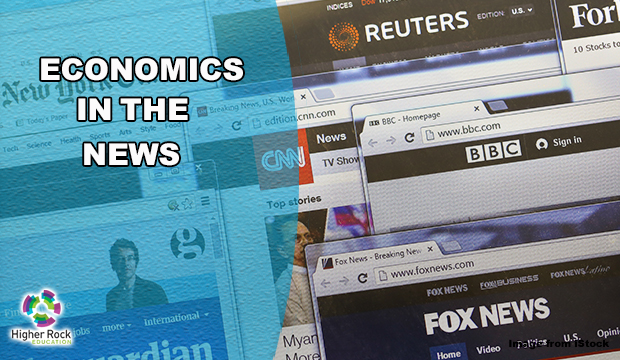
Economics in the News – Oct. 23-29, 2023
Economics impacts our lives every day. Below are some of the top storylines from this past week related to economics.
o Exxon Mobil and Chevron each have made big bets that the predictions of declining oil demand are wrong, each acquiring smaller companies that allow each of them to produce more oil and natural gas. Exxon Mobil agreed to purchase Pioneer Natural Resources for $60 million, while Chevron announced its proposed acquisition of Hess. The two largest oil companies in the United States, Exxon Mobil and Chevron committed to spend more than $50 billion, despite a report from the International Energy Agency that demand for oil, gas and other fossil fuels would peak by 2030.
It points to a large disconnect between the opinions of oil companies and energy experts, as oil companies have not been spending heavily on alternatives such as wind and solar power and electric car batteries. Energy experts believe that the fast growth in renewable energies and sales of electric cars will continue to surge. Oil companies believe that consolidation is important to allow them to invest in untested technology of capturing carbon dioxide and exploring the use of hydrogen. [The New York Times]
o Places in the United States are becoming difficult to insure. Surging insurance premiums in disaster-prone areas such as Florida are causing some Americans to move to less disaster-prone areas, while several insurance companies have withdrawn services for those same areas.
Experts fear that as climate change continues to take its toll, more areas will become uninsurable. To assist, forecasters are changing the way their models to adjust for catastrophe probabilities for any given year. [The Wall Street Journal]
o With Israel at war with Hamas and Ukraine fighting its war against Russia, leaders are worried that a surge of demand for weapons will cause a shortage of supplies. Production of supplies has increased since Russia’s invasion of Ukraine, but the output remains far below the amount of ammunition and equipment being used in Ukraine.
With demand increasing and production facilities operating at their capacity, prices of supplies have soared. The US has pumped $25 billion in contracts to help arm Ukraine, while replenishing American stockpiles. The European Union have also placed some orders, but far less than the US. The US is also a major supplier of military equipment and funding for Israel, with the European Union playing less of a role. [The Wall Street Journal]
o Millions of people have ditched traditional career paths to work as online creators, using their phones, cameras, computers and other devices to build a substantial following across social media platforms such as YouTube and TikTok. Some content creators build influences that rival the biggest names in entertainment, news and politics. The global content creation industry is valued at $250 billion, with YouTube estimating that 390,000 full-time jobs were supported by creators’ work.
The content creation age has transformed the way that younger Americans view culture, gain information, and helped in amassing huge levels of wealth and influence. The pay is unpredictable, the workload is demanding, and competition is intense. The rise of creators and wide range of platforms has made it easier to gain an audience. Being an influencer now ranks as one of the top career aspirations among American youth. But the industry is, for the most part, unregulated, as there are no laws concerning how influencers can earn a living or flex their power. [The Washington Post]
o Prices of Halloween candy have soared this year, making it more expensive to keep trick-or-treaters happy. Candy prices have seen a 7.5 percent increase compared to last September, with the price of cocoa skyrocketing. The price for the key ingredient for chocolate has risen 61 percent due to rains delaying harvest. That shortage is impacting candy makers such as Hershey’s or Mars.
Despite the increase in prices, Americans are expected to spend $3.6 billion on candy in 2023 – a 16 percent higher total than in 2022. Trick-or-treaters can expect more stringent portions of the candy they hand out and fewer full-sized candy bars. American families aren’t just spending on candy. The popularity of Halloween-themed lawn ornaments and inflatables has risen to a new record $12.2 billion. [FORTUNE]